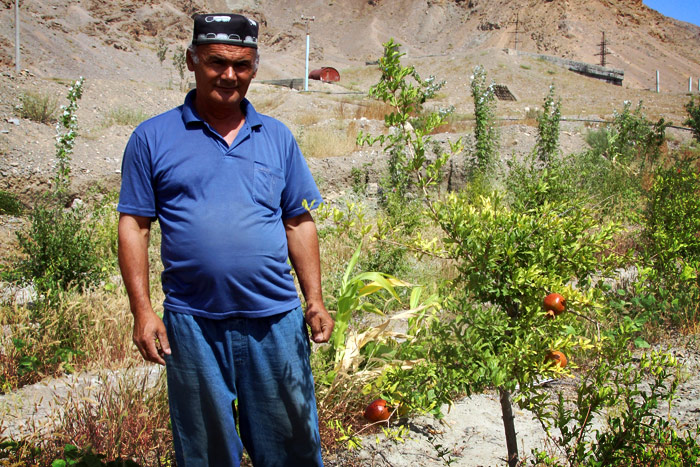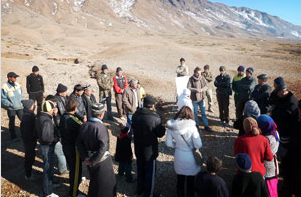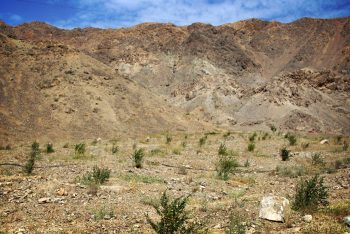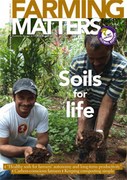In Central Asia, unsustainable land management has turned large areas of productive land into wastelands. “Not possible, no water, too hot…” has for a long time been the standard response from locals when asked why there has been so little effort to reverse natural resource degradation. But in recent years, innovative farmers like Ruzimatov Mahmudjon have successfully challenged this perception by clever strategies that use local organic waste materials.

Ruzimatov Mahmudjon lives with his family in a mountainous area of Isfara District in northern Tajikistan. Farming is not easy. The area is very dry, with long, hot summers. And the little rain, about 300 mm a year, generally falls during the winter months that are too cold for crops to grow. Like many family farmers, Mr Mahmudjon owns a small irrigated plot, 600 square metres, that he uses for fruit and vegetable production and as a tree nursery. He occasionally rents additional land to grow wheat and other staple crops and he also works as a wage labourer for larger farmers.
Located at the foot of an eroded mountain range, Mr Mahmudjon´s community has over the past 10 years repeatedly been affected by floods and debris flows, which even put the village school under threat. Members of the community decided to establish water diversion structures and dams above the village. However, the established structures had to be periodically repaired and reinforced. This was hardly a sustainable solution.
Degraded and underutilised land
This situation is not unique to Mr Mahmudjon’s community. Most of Tajikistan’s territory consists of mountainous rain fed land which in many areas, due to decades of overgrazing and deforestation, has become highly degraded. Soil erosion and declining soil organic matter have reduced soil fertility to the point that large tracts of the country are nowadays described as marginal or as wasteland. Land is producing less, rainfall has become erratic and communities are at risk of disasters in the form of floods, mud and debris flows.
New techniques for land restoration

In 2011, with support from the European Union, communities which had reported increasing problems with land degradation and flash floods learnt how to use locally available resources to integrate food production with land restoration.
Efficient water use, returning as much organic material back into the soils and the planting of selected shrub and tree species, that are able to grow even under harsh conditions, were at the core of the initiative. This was the starting point for the communities’ own experiments with land restoration, which eventually led to the development of further innovations by farmers such as Mr Mahmudjon.
Mr Mahmudjon did not attend any of the training sessions but later heard some neighbours speaking about them and they shared some of the training materials with him. Curious to see whether the simple techniques could really work, he decided at the start of 2012 to establish his own experimental plot of half a hectare on a compacted and stony area above the village. His efforts consisted of planting drought tolerant shrubs and trees, adding organic waste to planting holes and covering his soil with organic matter.
The opportunity to restore wastelands with waste materials seemed like a win-win situation said Mr Mahmudjon, “first, I was motivated by the idea to protect the school and the parts of the village that were at risk from floods, and then I realised that we can also get economic benefits from those wastelands.”
Choosing wisely
One element of Mr Mahmudjon’s strategy was to select the right trees. At the beginning he mainly planted highly drought tolerant shrub and tree species, such as almond, mulberry, pomegranate, a local highly drought tolerant elm species (Ulmus pumila), hawthorn, Russian olive (Eleagenus angustifolia), Chinese date (Ziziphus jujuba), pistachio and juniper. These trees are able to establish, even under harsh environmental conditions, and they develop strong and deep root systems, which allows them to survive even long periods of hot and dry weather with little to no irrigation.
Mr Mahmudjon’s first seedlings from 2011 helped to gradually improve the local microclimate. And in 2014, this gave Mahmudjon the confidence to introduce walnut and different varieties of apricots, which require more water and better soil. In addition, he started to experiment with lucerne and other nitrogen fixing legume plants for enhanced ground cover and soil improvement.
As much organic matter as possible

In addition to that, Mr Mahmudjon applied large amounts of organic matter in each planting hole. According to the original training materials, one or two buckets of well rotted animal manure should be added to the planting hole of each seedling, to increase the soil’s capacity to retain water.
It is understood that one tonne of dry, well decomposed organic material can store between 1000 and 1500 litres of water. However, Mr Mahmudjon considered the long, dry and hot summer season and the lack of water at his reforestation site, and he decided more was needed. He applied up to 15 kg of humid animal manure per tree, and in addition incorporated large amounts of organic waste from a local cotton carding machine. These machines are used by the local population to periodically clean and soften pillows and mattresses filled with cotton fibre.
The waste material, old cotton fibre, was considered useless by local people and was available for free. Mr Mahmudjon recognised this to be a valuable resource to support his reforestation efforts.
From wasteland to productive slopes
The application of manure and cotton fibre on the soil and in tree holes proved highly suitable to improve the physical and chemical properties of the soil, and promote plant growth. The manure provides readily available nutrients for plant growth and increases the general water holding capacity of the soils. The additionally applied cotton fibre seems to further improve the soils physical structure, thereby raising its water holding capacity. Combined with the careful selection of drought-tolerant tree and shrub species, this meant that the demand for irrigation water during the first years after planting was drastically reduced.
Mr Mahmudjon waters his seedlings during the heat of the dry summer only once every 40 days, instead of every second week. With his planting technique, Mr Mahmudjon has brought down irrigation water requirements to about 30% of the commonly applied rate. This has more than compensated him for the extra effort when he planted the seedlings.
With the idea to further save time and labour, he recently constructed a simple rainwater harvesting structure, which will directly supply his reforestation site with irrigation water. His next ideas are to experiment with small drip irrigation equipment.
In Tajikistan all land formally belongs to the state and can only be leased. For his reforestation plot, Mr Mahmudjon currently holds an informal lease agreement with the local authorities. However, he is trying to get a forest farm certificate, which according to the current version of Tajikistan’s Land Code, provides rights for 20 years, with the possibility for extension. There are more and more voices in Tajikistan urging the government to increase the duration of the first lease period in order to stimulate community based efforts for reforestation, such as Mr Mahmudjon’s.
Innovation brings optimism
Through his efforts, Mr Mahmudjon has seen an amazing 95% survival rate of his seedlings up to now, and after three years, some of his plantings such as pomegranate already started to produce their first fruits. He plans to use part of the increased fruit production for family consumption, and to sell part of the harvest for a new and welcome cash income.
Mr Mahmudjon more than doubled the size of his reforestation plot, which today covers 1.25 hectares. Stimulated by this experience, six of his neighbours have set up additional reforestation plots on another four hectares of former wasteland. In addition, farmers from neighbouring villages have also started to establish reforestation sites, covering another 5 ha. And, they have identified more local possibilities to exploit organic waste material to restore degraded soils. Large amounts of cotton fibre from cotton processing factories, bark and sawdust from sawmills, and wastes from nearby markets are other freely available organic resources.
To spread these practices even further, there is a need to overcome doubts that degraded land can become productive once again. But Mr Mahmudjon is extremely optimistic that his results will convince people: “My reforestation plot shows that even wastelands with lots of stones and no connection to major irrigation facilities can be converted into something very useful.”
All in all Mr Mahmudjon´s experience is a good example of how organic waste, instead of contributing to contamination, can support land and soil restoration. More integrated and efficient use of locally available resources offers huge potential for more productive use of degraded lands.
Frank Löwen
Frank Löwen is as a freelance consultant specialising on land restoration. He is cofounder of Down to Earth Consult, a small enterprise in Germany, dedicated to strengthening self reliance of rural communities through more efficient use of locally available resources.
Email: floewen@gmx.de

